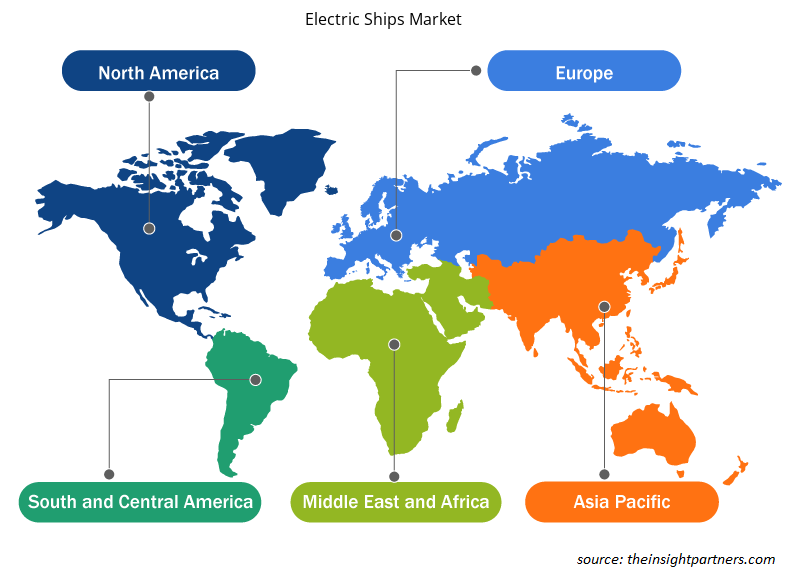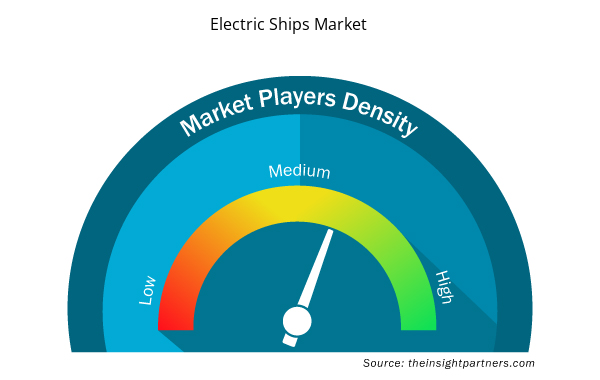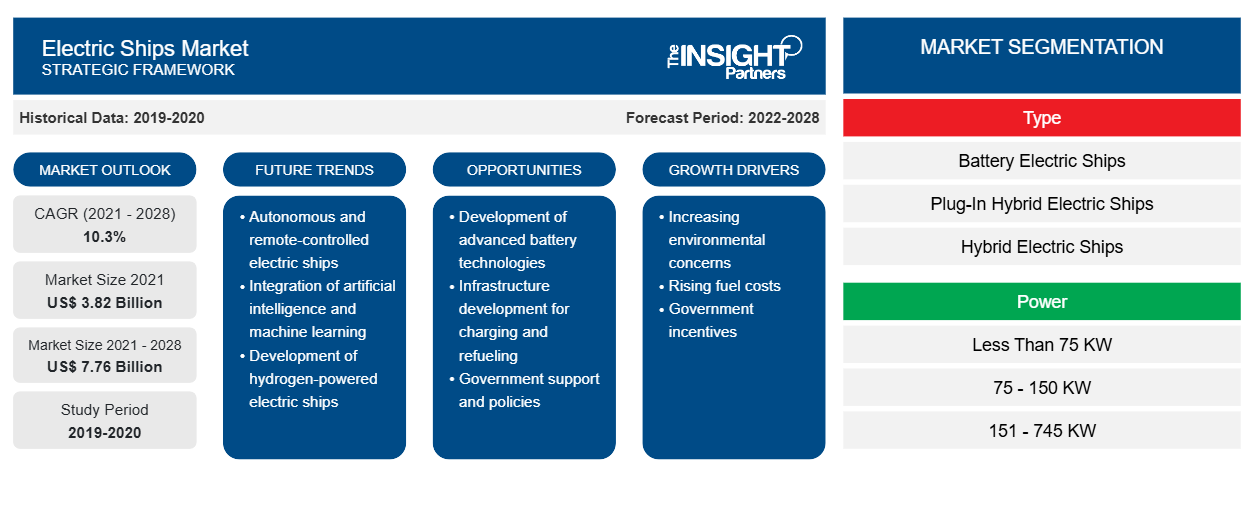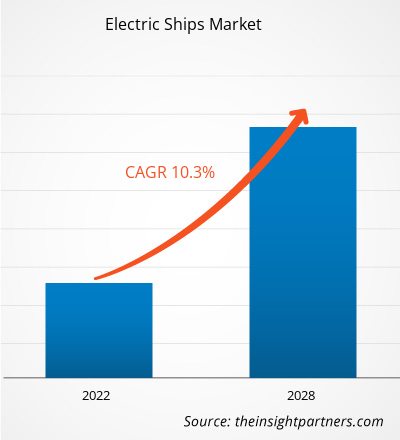El mercado de barcos eléctricos se valoró en US$ 3.820 millones en 2021 y se estima que crecerá a una CAGR del 10,3% entre 2021 y 2028.
Un barco eléctrico es cualquier barco o embarcación cuya tecnología de propulsión principal es un sistema de accionamiento eléctrico. Puede ser un barco o embarcación eléctrica de batería completa, eléctrica de pila de combustible de hidrógeno , eléctrica híbrida, desde remolcadores, transbordadores, buques de carga y barcazas hasta barcos turísticos, arrastreros de pesca, yates de crucero y vehículos submarinos no tripulados (UUV). Los barcos eléctricos se impulsan eléctricamente, a diferencia de los barcos con motor diésel convencionales. Estos barcos utilizan un dispositivo de almacenamiento de batería como fuente de energía para impulsar los motores eléctricos. Se pueden utilizar numerosos tipos de baterías en un barco eléctrico, incluidas las baterías de iones de litio, las baterías de plomo-ácido y las pilas de combustible. Los barcos eléctricos son principalmente transbordadores y pequeños barcos de pasajeros en vías navegables interiores que navegan completamente con electricidad. Viajan solo distancias cortas con ~80 km en una sola carga. Además, los barcos con energía solar también se utilizan en barcos ligeros que requieren baja potencia de salida. Sin embargo, los requisitos de energía de los buques de carga no se pueden satisfacer con un sistema completamente eléctrico debido a su gran peso; por lo tanto, los buques de carga utilizan un sistema híbrido diésel-eléctrico.
Personalice este informe según sus necesidades
Obtendrá personalización en cualquier informe, sin cargo, incluidas partes de este informe o análisis a nivel de país, paquete de datos de Excel, así como también grandes ofertas y descuentos para empresas emergentes y universidades.
- Obtenga las principales tendencias clave del mercado de este informe.Esta muestra GRATUITA incluirá análisis de datos, desde tendencias del mercado hasta estimaciones y pronósticos.
Impacto de la pandemia de COVID-19 en el mercado de los barcos eléctricos
La pandemia de COVID-19 afectó negativamente al mercado de los barcos eléctricos . La pandemia provocó impactos globales sin precedentes en la movilidad humana. En el océano, las actividades basadas en barcos se ven afectadas debido a las severas restricciones a los movimientos humanos y los cambios en el consumo de bienes. Algunos países han cerrado su industria de cruceros debido a la pandemia de COVID-19. Sin embargo, algunas líneas de cruceros están tratando de reanudar sus actividades durante la pandemia. Las actividades humanas en el océano han cambiado radicalmente por la pandemia de COVID-19, con informes de restricciones portuarias y cambios en los patrones de consumo que afectan a múltiples sectores marítimos, pesca, transbordadores de pasajeros y cruceros. Sin embargo, en algunas regiones, el envío de mercancías se declaró esencial durante el cierre, lo que creó una oportunidad lucrativa para el mercado de los barcos eléctricos.
Perspectivas del mercado de los barcos eléctricos
Aumento de la adopción de sistemas de propulsión híbridos y eléctricos para modernizar los buques
La modernización de los buques está ganando interés y atrae a los armadores y constructores navales para prolongar la vida útil de sus buques existentes. Este proceso ofrece la oportunidad de reducir el consumo de combustible y mantenerse actualizado con las últimas soluciones ecológicas como un procedimiento rentable. La modernización se está convirtiendo en una práctica común en la industria marítima. Los constructores navales están avanzando hacia la automatización, integrando los buques de nueva construcción y modernizando los buques existentes con sistemas de propulsión híbridos y eléctricos. Este sistema es una opción conveniente para modernizar buques obsoletos con un enorme potencial de modernización, incluidos transbordadores, buques portacontenedores, cruceros, remolcadores y buques de carga general. Los constructores navales optan por modernizar los buques con un sistema de propulsión híbrido-eléctrico o un sistema de propulsión totalmente eléctrico, ya que es una opción relativamente más barata que comprar un buque nuevo. Además, varios constructores navales europeos están modernizando activamente su flota actual de buques con sistemas de propulsión híbridos y eléctricos. Por ejemplo, según el artículo publicado por Riviera Maritime Media Ltd, en marzo de 2020, los propietarios de buques de suministro en alta mar (OSV) invirtieron en la modernización de flotas propulsadas por diésel-eléctricos/GNL con propulsión híbrida por batería, una medida que está dando sus frutos para el fletador, el propietario y las cuestiones ambientales en Noruega. Estos factores han dado lugar a la adopción de sistemas de propulsión híbridos y eléctricos para modernizar los buques.
Perspectivas del mercado basadas en tipos
Según el tipo, el mercado de los barcos eléctricos se segmenta en barcos eléctricos de batería, barcos eléctricos híbridos enchufables y barcos eléctricos híbridos. El segmento de los barcos eléctricos híbridos lideró el mercado en 2020. La confiabilidad que ofrecen los barcos eléctricos híbridos respalda su demanda debido al uso de sistemas de propulsión complementarios y una mayor velocidad, lo que puede reducir el riesgo de falla y cubrir mayores distancias en menos tiempo. Además, la propulsión de los barcos eléctricos híbridos se puede propulsar de dos maneras: eléctrica (a través de diésel-eléctrico o impulsado por batería) o mecánica (accionamiento directo por diésel). Además, los propietarios de barcos o las empresas navieras y logísticas de todo el mundo prefieren los barcos eléctricos híbridos, ya que permiten un menor consumo de combustible y ayudan a reducir los costos operativos. El uso de propulsión diésel-eléctrica a baja potencia y propulsión directa por diésel cuando se necesita alta potencia para navegar en aguas interiores con diferentes condiciones de velocidad permite una reducción en el costo operativo en el barco eléctrico. Esta es una forma más inteligente de utilizar la energía disponible y ahorrar en costos de combustible mediante el uso de propulsión de barco eléctrico híbrido.
Los actores que operan en el mercado de los barcos eléctricos adoptan estrategias, como fusiones, adquisiciones e iniciativas de mercado, para mantener sus posiciones en el mercado. A continuación, se enumeran algunos de los desarrollos de los actores clave.
- En noviembre de 2021, BAE Systems lanzó un sistema de propulsión y energía de última generación para ayudar a los operadores marítimos a alcanzar cero emisiones. Proporciona una solución flexible que mejora la eficiencia eléctrica y la autonomía de la embarcación, aumenta la potencia de propulsión y simplifica la instalación.BAE Systems launched a next-generation power and propulsion system to help marine operators reach zero emissions. It provides a flexible solution improving electrical efficiency and vessel range, increasing propulsion power, and simplifying installation.
- En septiembre de 2020, Kolumbus (una empresa de movilidad) y Fjellstrand (un constructor naval) firmaron un contrato para entregar el primer ferry rápido totalmente eléctrico del mundo. Este proyecto había recibido financiación del programa de investigación e innovación Horizonte 2020 de la Unión Europea.
Según el tipo, el mercado de barcos eléctricos se segmenta en barcos eléctricos de batería, barcos eléctricos híbridos enchufables y barcos eléctricos híbridos. Según la potencia, el mercado de barcos eléctricos se segmenta en menos de 75 kW, 75-150 kW, 151-745 kW, 746-7560 kW y más de 7560 kW. Según el alcance, el mercado de barcos eléctricos se clasifica en menos de 50 km, 50-100 km, 101-1000 km y más de 1000 km. Según el tipo de barco, el mercado de barcos eléctricos se segmenta en cruceros, transbordadores, petroleros, graneleros, barcos pesqueros, destructores, portaaviones y otros. Por geografía, el mercado de barcos eléctricos se segmenta en cinco regiones principales: América del Norte, Europa, Asia Pacífico (APAC), Medio Oriente y África (MEA) y América del Sur (SAM).
Perspectivas regionales del mercado de barcos eléctricos
Los analistas de Insight Partners explicaron en detalle las tendencias y los factores regionales que influyen en el mercado de barcos eléctricos durante el período de pronóstico. Esta sección también analiza los segmentos y la geografía del mercado de barcos eléctricos en América del Norte, Europa, Asia Pacífico, Oriente Medio y África, y América del Sur y Central.

- Obtenga los datos regionales específicos para el mercado de barcos eléctricos
Alcance del informe sobre el mercado de barcos eléctricos
| Atributo del informe | Detalles |
|---|---|
| Tamaño del mercado en 2021 | US$ 3.82 mil millones |
| Tamaño del mercado en 2028 | 7.760 millones de dólares estadounidenses |
| CAGR global (2021-2028) | 10,3% |
| Datos históricos | 2019-2020 |
| Período de pronóstico | 2022-2028 |
| Segmentos cubiertos | Por tipo
|
| Regiones y países cubiertos | América del norte
|
| Líderes del mercado y perfiles de empresas clave |
|
Densidad de actores del mercado de barcos eléctricos: comprensión de su impacto en la dinámica empresarial
El mercado de barcos eléctricos está creciendo rápidamente, impulsado por la creciente demanda de los usuarios finales debido a factores como la evolución de las preferencias de los consumidores, los avances tecnológicos y una mayor conciencia de los beneficios del producto. A medida que aumenta la demanda, las empresas amplían sus ofertas, innovan para satisfacer las necesidades de los consumidores y aprovechan las tendencias emergentes, lo que impulsa aún más el crecimiento del mercado.
La densidad de actores del mercado se refiere a la distribución de las empresas o firmas que operan dentro de un mercado o industria en particular. Indica cuántos competidores (actores del mercado) están presentes en un espacio de mercado determinado en relación con su tamaño o valor total de mercado.
Las principales empresas que operan en el mercado de barcos eléctricos son:
- Sistemas BAE
- Compañía de barcos eléctricos Duffy
- Fjellstrand AS
- X Costa
- Embarcación eléctrica de General Dynamic
Descargo de responsabilidad : Las empresas enumeradas anteriormente no están clasificadas en ningún orden particular.

- Obtenga una descripción general de los principales actores clave del mercado de barcos eléctricos
Perfiles de empresas
- Sistemas BAE
- Compañía de barcos eléctricos Duffy
- Fjellstrand AS
- X Costa
- Embarcación eléctrica de General Dynamic
- Grutas de Hurti
- Soluciones energéticas MAN
- PortLiner
- Energía Siemens
- VARD COMO
- Análisis histórico (2 años), año base, pronóstico (7 años) con CAGR
- Análisis PEST y FODA
- Tamaño del mercado Valor/volumen: global, regional, nacional
- Industria y panorama competitivo
- Conjunto de datos de Excel



Report Coverage
Revenue forecast, Company Analysis, Industry landscape, Growth factors, and Trends

Segment Covered
This text is related
to segments covered.

Regional Scope
North America, Europe, Asia Pacific, Middle East & Africa, South & Central America

Country Scope
This text is related
to country scope.
Preguntas frecuentes
The idea of retrofitting ships is gaining interest and is attracting shipowners/shipbuilders to extend the lifetime of their existing ships. Such a process provides a chance to reduce fuel consumption and stay up to date with the latest eco-friendly solutions as a cost-effective procedure. Retrofitting is becoming a common practice in the maritime industry. Shipbuilders are moving toward automation, integrating new build ships, and retrofitting existing ships with hybrid and electric propulsion systems. A hybrid-electric propulsion system is a convenient choice for retrofitting outdated ships. Ships have a large retrofit potential, including ferries, container vessels, cruise ships, tugboats, and general cargo ships. Shipbuilders choose to retrofit ships with a hybrid-electric propulsion system or a fully electric propulsion system as it is a relatively cheaper option than purchasing a new ship. These factors mentioned above have resulted in the adoption of hybrid and electric propulsion systems for retrofitting ships.
Nowadays, hybrid propulsion technology is commonly used for small vessels such as ferries. For instance, according to the article published by the Institution of Engineering and Technology, in January 2019, the UK shipbuilder Ferguson Marine had built Catriona, a £12.3 million (US$ 15.82 million) diesel-electric-battery-power hybrid ferry for CalMac to use on its Clyde and Hebridean routes. However, with the development of marine electric propulsion technology and alternative fuels such as fuel cells, there is a massive opportunity for manufacturers to work on hybrid-electric propulsion systems for larger ships. The stricter emissions targets have encouraged shipbuilders to install a hybrid propulsion system on existing or new vessels. The research & development (R&D) department for ABB marine activities in Norway stated that the hybrid propulsion systems significantly reduce both fuel consumption and emissions, according to the article published by the Institution of Engineering and Technology in January 2019. Therefore, with the growing emission control norms, the adoption of hybrid-electric propulsion systems is increasing among larger ships, creating a massive opportunity for manufacturing larger ships using hybrid-electric propulsion systems.
Europe dominated the Electric Ships market in 2020 with a share of 48.6% and is expected to continue its dominance by 2028. North America is the second-largest contributor to the global Electric Ships market in 2020, followed by Asia Pacific.
The major companies in Electric Ships market are BAE Systems, Duffy Electric Boat Company, Fjellstrand AS, X Shore, General Dynamic Electric Boat, Hurtigruten, MAN Energy Solutions, PortLiner, Siemens Energy, and VARD AS
The major Application in Electric Ships includes cruise ship, ferries, tankers, bulk carriers, fishing vessels, destroyers, aircraft carriers, and others. In terms of market share, the electric ships market was dominated by the ferries segment in 2020.
The electric ships market, by type is segmented into battery electric ships, plug-in hybrid electric ships, and hybrid electric ships. The Electric Ships market was dominated by the hybrid electric ships segment in 2020.
Trends and growth analysis reports related to Automotive and Transportation : READ MORE..
The List of Companies - Electric Ships Market
- BAE Systems
- Duffy Electric Boat Company
- Fjellstrand AS
- X Shore
- General Dynamic Electric Boat
- Hurtigruten
- MAN Energy Solutions
- PortLiner
- Siemens Energy
- VARD AS
The Insight Partners performs research in 4 major stages: Data Collection & Secondary Research, Primary Research, Data Analysis and Data Triangulation & Final Review.
- Data Collection and Secondary Research:
As a market research and consulting firm operating from a decade, we have published and advised several client across the globe. First step for any study will start with an assessment of currently available data and insights from existing reports. Further, historical and current market information is collected from Investor Presentations, Annual Reports, SEC Filings, etc., and other information related to company’s performance and market positioning are gathered from Paid Databases (Factiva, Hoovers, and Reuters) and various other publications available in public domain.
Several associations trade associates, technical forums, institutes, societies and organization are accessed to gain technical as well as market related insights through their publications such as research papers, blogs and press releases related to the studies are referred to get cues about the market. Further, white papers, journals, magazines, and other news articles published in last 3 years are scrutinized and analyzed to understand the current market trends.
- Primary Research:
The primarily interview analysis comprise of data obtained from industry participants interview and answers to survey questions gathered by in-house primary team.
For primary research, interviews are conducted with industry experts/CEOs/Marketing Managers/VPs/Subject Matter Experts from both demand and supply side to get a 360-degree view of the market. The primary team conducts several interviews based on the complexity of the markets to understand the various market trends and dynamics which makes research more credible and precise.
A typical research interview fulfils the following functions:
- Provides first-hand information on the market size, market trends, growth trends, competitive landscape, and outlook
- Validates and strengthens in-house secondary research findings
- Develops the analysis team’s expertise and market understanding
Primary research involves email interactions and telephone interviews for each market, category, segment, and sub-segment across geographies. The participants who typically take part in such a process include, but are not limited to:
- Industry participants: VPs, business development managers, market intelligence managers and national sales managers
- Outside experts: Valuation experts, research analysts and key opinion leaders specializing in the electronics and semiconductor industry.
Below is the breakup of our primary respondents by company, designation, and region:

Once we receive the confirmation from primary research sources or primary respondents, we finalize the base year market estimation and forecast the data as per the macroeconomic and microeconomic factors assessed during data collection.
- Data Analysis:
Once data is validated through both secondary as well as primary respondents, we finalize the market estimations by hypothesis formulation and factor analysis at regional and country level.
- Macro-Economic Factor Analysis:
We analyse macroeconomic indicators such the gross domestic product (GDP), increase in the demand for goods and services across industries, technological advancement, regional economic growth, governmental policies, the influence of COVID-19, PEST analysis, and other aspects. This analysis aids in setting benchmarks for various nations/regions and approximating market splits. Additionally, the general trend of the aforementioned components aid in determining the market's development possibilities.
- Country Level Data:
Various factors that are especially aligned to the country are taken into account to determine the market size for a certain area and country, including the presence of vendors, such as headquarters and offices, the country's GDP, demand patterns, and industry growth. To comprehend the market dynamics for the nation, a number of growth variables, inhibitors, application areas, and current market trends are researched. The aforementioned elements aid in determining the country's overall market's growth potential.
- Company Profile:
The “Table of Contents” is formulated by listing and analyzing more than 25 - 30 companies operating in the market ecosystem across geographies. However, we profile only 10 companies as a standard practice in our syndicate reports. These 10 companies comprise leading, emerging, and regional players. Nonetheless, our analysis is not restricted to the 10 listed companies, we also analyze other companies present in the market to develop a holistic view and understand the prevailing trends. The “Company Profiles” section in the report covers key facts, business description, products & services, financial information, SWOT analysis, and key developments. The financial information presented is extracted from the annual reports and official documents of the publicly listed companies. Upon collecting the information for the sections of respective companies, we verify them via various primary sources and then compile the data in respective company profiles. The company level information helps us in deriving the base number as well as in forecasting the market size.
- Developing Base Number:
Aggregation of sales statistics (2020-2022) and macro-economic factor, and other secondary and primary research insights are utilized to arrive at base number and related market shares for 2022. The data gaps are identified in this step and relevant market data is analyzed, collected from paid primary interviews or databases. On finalizing the base year market size, forecasts are developed on the basis of macro-economic, industry and market growth factors and company level analysis.
- Data Triangulation and Final Review:
The market findings and base year market size calculations are validated from supply as well as demand side. Demand side validations are based on macro-economic factor analysis and benchmarks for respective regions and countries. In case of supply side validations, revenues of major companies are estimated (in case not available) based on industry benchmark, approximate number of employees, product portfolio, and primary interviews revenues are gathered. Further revenue from target product/service segment is assessed to avoid overshooting of market statistics. In case of heavy deviations between supply and demand side values, all thes steps are repeated to achieve synchronization.
We follow an iterative model, wherein we share our research findings with Subject Matter Experts (SME’s) and Key Opinion Leaders (KOLs) until consensus view of the market is not formulated – this model negates any drastic deviation in the opinions of experts. Only validated and universally acceptable research findings are quoted in our reports.
We have important check points that we use to validate our research findings – which we call – data triangulation, where we validate the information, we generate from secondary sources with primary interviews and then we re-validate with our internal data bases and Subject matter experts. This comprehensive model enables us to deliver high quality, reliable data in shortest possible time.


 Obtenga una muestra gratuita de este informe
Obtenga una muestra gratuita de este informe